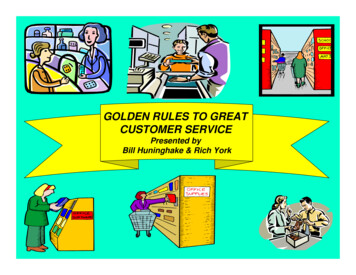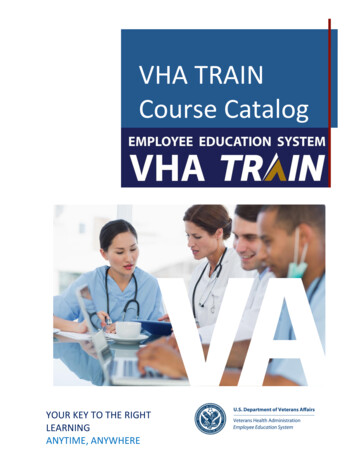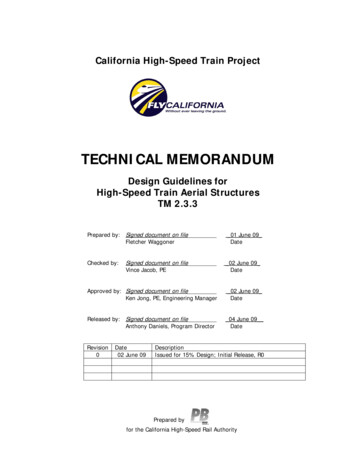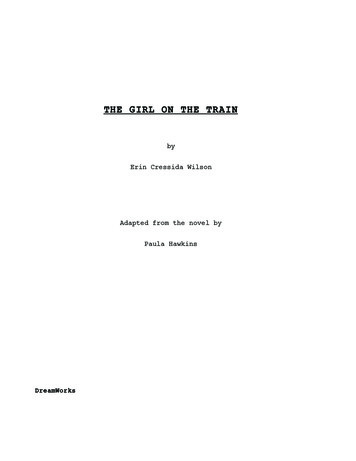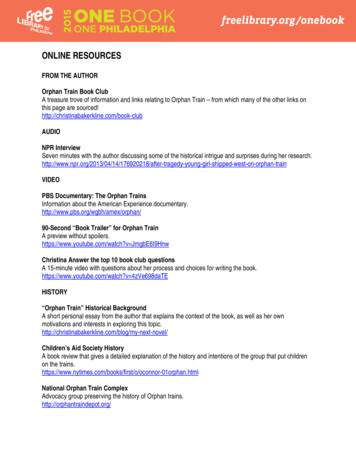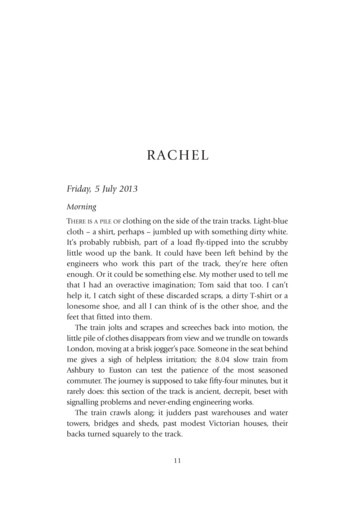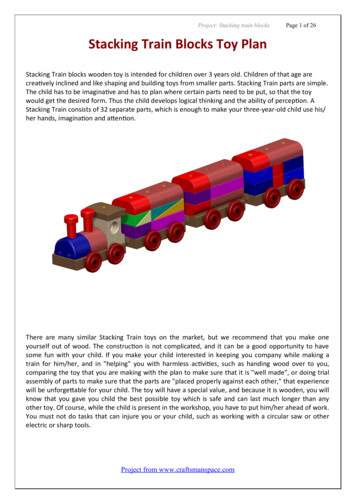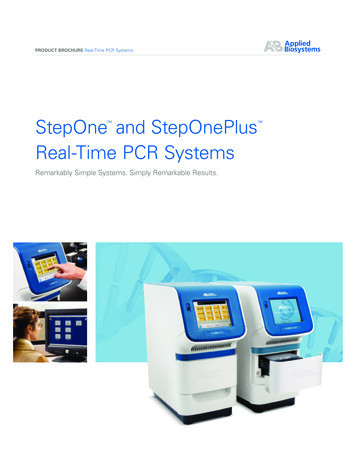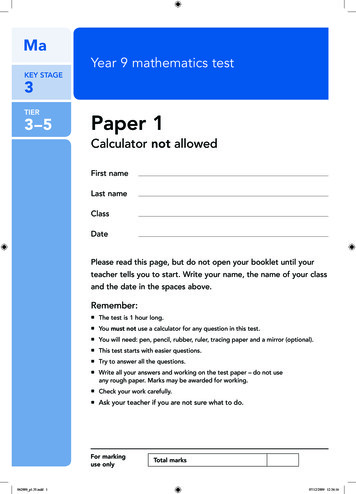Transcription
Journal of Applied Technology and Innovation (e-ISSN: 2600-7304) vol. 3,no. 1, (2019)1RT-Train: A Real-Time Tracking System for Public Train in MalaysiaNg Seng Yong1, Mien May Chong2 and Lai Chew Ping3School of Computing, Faculty of Computing, Engineering & Technology,Asia Pacific University of Technology & Innovation (APU),Technology Park Malaysia, Bukit Jalil, 57000 Kuala Lumpur, Malaysia.1ngsengyong96@gmail.com, 2mienmay@apu.edu.my, 3chewping@apiit.edu.myAbstract— Real-time Public Train Tracking System is a system forthe train user to check the train schedule, track the upcomingtrain’s location in real-time, and receiving announcement via pushnotification. In this paper, a new prototype of the Real-TimePublic Train Tracking System called “RT-Train” was introduced.This proposed system can reduce the congestion of train users andallows train users to know the accurate train schedule and the realtime location of the train. Besides, it allows the train users toreceive the push notification if the train is delayed. In this paper,we had also included an Abstract Architecture in explaining thesystem flow of the proposed system by using use case diagram. Inthe testing stage, four (4) major sub stages includes Unit Testing,Integration Testing, System Testing and User Acceptance Testing(UAT) have been done. From the results, all the actual results aresame as the expected results. As a conclusion, the proposed systemhas achieved all the objectives that aimed by us.towards the public transport also one of the important issuesthat affecting the usage of the public transport.Index Terms— Real-time Tracking, Public Train, Delay, GPS,Location Detection1.IntroductionNowadays, in this fast life where everyone is in a hurry to reachtheir destination, railway in Malaysia has been playing a majorrole in the economic and social advancement of the nation.There are many types of rail transports in Malaysia, such asheavy rail (which is including the commuter rail), light railtransit (LRT), mass rapid transit (MRT), monorail, airport raillink (ERL) and a funicular railway line in Penang (Masirin etal., 2017). Commonly, the heavy rail is used for the intercitypassenger services or the freight transport services; while theLRTs, MRTs and monorail are used for the intra-city urbanpublic transport.The intercity rail network in the Peninsular Malaysiacomprises of KTM West Coast Line and KTM East Coast Line.KTM West Coast Line is used in the between of Singapore andPadang Besar, Perlis, and on the Malaysian-Thai border. For theKTM East Coast Line, it is used in the between Gemas inNegeri Sembilan and Tumpat in Kelantan. From the Figure 1,it shows that started from the year of 2012 for the year of 2015,the number of the railway passengers was increasing. However,when reached for the year of 2016, the statistics were shownthat the number of passengers has been reduced compared tothe year of 2015. The main reason of the decreasing is becausethe train fares were increasing in Malaysia during the year endof 2015. (Chan, 2015). Besides, public perception and attitudeFigure 1: Statistic of users that use public transport(Ministry ofTransport Malaysia, 2017)Thus, to develop a suitable transport network for thecommunity, it is important to study on the current perceptionsand attitudes of the users (Rojas López and Wong, 2017). In thisproject, before introducing a new prototype of Real-TimeTracking System for Public Train in Malaysia, we had also donea survey that focusing on the public perception and attitudetowards the public train in Malaysia. All the survey results areincluded in the result and discussion section.2.Backgrounds and Related WorksIn this section, we briefly discussed on the latest research topicsthat related to the public transport, and also the existing publictrain mobile application that available in Malaysia and othercountries.2.1. Location Tracking and Time PredictionLocation tracking and time prediction is one of the importantresearches have been done in the public transport area. Sinha etal. (2017) is one of the researchers that doing the research onthe bus location tracking. They developed a real-time bustracking application by using the GPS API. This system able todisplay the real-time location and timetable of the bus by usingGPS. Besides, in the system, it's able to upload the current
Journal of Applied Technology and Innovation (e-ISSN: 2600-7304) vol. 3,no. 1, (2019)location of the bus to the server; while the server able tobroadcast the bus location to the students automatically byusing the SMS. For the bus drivers, they only need to log in tothe system and use their mobile phone to act as a GPS receiverfor locating the current location. They can update the server inevery moment in the form of longitude and latitude (Sinha etal., 2017).On the other hand, Bhardwaj, Daphal and Nerkar (2016), alsopresented a new bus arrival time prediction system on the GPSbased sensing. Figure 2 shows the system architecture of theirproposed system. The technologies that used in their project areusing GPS, Global System for Mobile Communication) GSMtechnology. The real-time coordinates of moving vehicle willbe obtained from the GPS device and report the position of thevehicle on request for passengers (Bhardwaj, Daphal andNerkar, 2016).Besides, other researchers such as Farkas et al. (2015), alsofocusing their research on the area of crowd-sensing basedpublic transport information service. They proposed a systemcalled “Traffic Info” in their paper. This system can visualizethe real-time public transport information of the given city onthe Google Maps and also can do a live update on the transportschedule based on the automatic stop event detection of thepublic transport vehicles.In the paper of Gholami and Sotskov (2014), they had donea research on the total train tardiness issue. In their research,there are three stages of strategy to reduce the delay in trainscheduling. And, from the computational results, it shows thattheir proposed idea was very useful to reduce the total tardiness,total completion time and make span in the train scheduling.Below are the strategy stages that presented by Gholami andSotskov (2014):1.2.3.Figure 2: Architecture of bus arrival time prediction systemfrom Bhardwaj, Daphal and Nerkar (2016)In the paper of Salunkhe et al. (2018), they presented a busarrival time prediction system for the users too. However, theirproposed system is based on the user participatory sensing withthe smart application. In their system, users who are waiting atthe bus stop can request for a bus. When the number of requestsexceeds more than a certain limit in a control room, a bus willbe sent to the location of the request. Besides, they installed theRaspberry pi with a GPRS module in each bus, so that the userscan track the location of the bus and the accurate timetable byusing the GPRS tracking. Figure 3 shows the proposedarchitecture from the paper of Salunkhe et al. (2018).2Pre-scheduling algorithm executed to achieve somedata about trains.The departure time of the trains is modified to decreasetrain delays.A controllable processing time module tries to reducetrain delays as much as possible via increasing speedsof some trains.Moreover, Walde et al. (2014) and Rahman, Wirasinghe andKattan (2018) also done a research on the location and timeprediction area. To give numerous services to the user based ontheir location, Walde et al. (2014) had implemented locationbased services through Walk Score Transit and Google WebServices APIs on Android Phones. The application can requestfor periodic update of the device location information andregister an intent receiver for proximity alerts like when thedevice is entering and existing from an area of giving longitude,latitude and radius (Walde et al., 2014). For Rahman,Wirasinghe and Kattan (2018), they had analyzed the changesof bus travel time characteristics as pseudo horizon varies andhow such characteristics can be applied to real-time bus arrivalestimation in their paper.2.2. Existing Public Trains’ Mobile ApplicationRecently, to improve the service quality of a public transport,there are some mobile application have been developed for theusers. Below are the current public train mobile application thatused in Malaysia and other countries.2.2.1. MoovitFigure 3: Architecture of bus arrival time prediction systemfrom Salunkhe et al. (2018)Moovit is an application that gives a peace of mind for thepublic transportation users. It allows users to discover their bestroutes to anywhere in the city. Whenever users need a directionto the destination, Moovit has built-in a feature that allows toget detailed itineraries and provide GPS for the transit withstep-by-step guidance from destination A to destination B.Besides, it has an automatic notification to remind the userswhenever the users have set a targeted station, so that they willnever miss a stop. Moreover, it allows users to make their
Journal of Applied Technology and Innovation (e-ISSN: 2600-7304) vol. 3,no. 1, (2019)favorite locations. Therefore, users can just get 1-tap and it willdirect them to the most travelled places. In addition, wheneverusers need the information on nearby transit, it has provided areal-time status to let them know when do they need to be at thestation and allows them to know where is the nearby stations byviewing all lines running at the station around their location.Other than that, users can get the crucial information of trainstations. For example, schedules of the train from each platformas well as the last ride of the night. Moreover, Moovit will senda service alert if there is any announcement made by trainmanagement.3interchange train in between. Lastly, there are multiplelanguage support for the system. Figure 5 below shows some ofthe screenshots in the Malaysia Rail Map – Kuala Lumpurapplication.Figure 5: Malaysia Rail Map – Kuala Lumpur Application(STUDIO, 2018)2.2.3. KL TransitFigure 4: Moovit Application (Moovit, 2018)Last but not least, it has provided a route and system mapsfor users to download it when there is an internet connectionwith the application and use it even if there is no internetconnection to the application. So far, there are more than 150million of the users in over 2200 cities throughout the worldused this application (Moovit, 2018). Figure 4 above showssome of the screenshots in the Moovit application.2.2.2. Malaysia Rail Map – Kuala LumpurMalaysia Rail Map is developed by TOKYO STUDIO INC.This system has covered all the railway in Malaysia whichincludes Light Rail Transit (LRT), Keretapi Tanah Melayu(KTM), KL Monorail, KLIA Express, and some of the otherrailway information. The system does not require registrationand perform login. The system allows user to search the station.However, this system does not provide any train schedule totrain user which is the most important information for trainusers. Moreover, the system allows the user to locate theircurrent location and see what the public transportation isnearby. Furthermore, there is train information for every stationthat is provided by the system. Besides, it can also check thetweets around the station that has connected and linked withTwitter. There is some weather information from the stationthat allows users to know. The system allows user to knowwhen they need to change their train if there is a need toKL Transit application, which shows in Figure 6 below wasdeveloped by SearchGuru Sdn Bhd. The system has justincluded the train schedule for Keretapi Tanah Melayu (KTM).The system does not require registration and perform login. Theuser of the system is allowed to check the schedule of the KTMby selecting the departure station and the destination station.After by selecting these two stations, click the “Check” buttonto check the schedule of the train where what is the next fewtrain’s schedule from the departure station. However, the trainschedule is fixed for a few years, there is no update for the trainschedule. The user is able to check the train schedule up to afew hundred years later.Figure 6: KL Transit Mobile Application (SearchGuru, 2018)
Journal of Applied Technology and Innovation (e-ISSN: 2600-7304) vol. 3,no. 1, (2019)Besides, the ticket fare from the departure station todestination station will be shown at bottom of the system afterthe user clicked “Check”. Moreover the system allows the userto set reminders and the system will remind user 15 minutesbefore the departure time so that they will never miss the train.Lastly, the system allows the user to share the application totheir friends or family to download it and use it from GooglePlay Store or Apple AppStore.4the proposed system. For the Interactive DevelopmentEnvironment (IDE), the developer has chosen the AndroidStudio. There are some Libraries and Tools also have beenintegrated in this project, such as Firebase System and GoogleMap API. Figure 7 shows the user roles that involved in ourproposed system.2.3. Features Comparison TableCreate ScheduleIn this section, we briefly discussed on the features of theexisting systems and the proposed system (RT-Train). From theTable 1, we can see that the proposed system has all thefunctions where some of the existing systems does not have.Check ScheduleUpdate ScheduleSearch Where to goAdminLoginTable 1: Comparison of features with Moovit, Malaysia RailMap, KL Transit, and Proposed SystemReceive TrainDeparture NotificationSend DepartureNotificationTrainUserFeaturesMoovitPlan JourneyReal-Timetracking on thetrainTraindeparturenotificationLive Directionswith Get OffNotificationsTraininformationfrom everystation MalaysiaRail Map KLTransit ProposedSystem Service Alerts Route &System MapsStops &transferinformation ofall linesFreeautomaticallyupdates to thelatest versionsof mapsSwitch toStreet MapView at everystationMultiplelanguages 3.Send DelayNotificationCheck AnnouncementCheck UpcomingTrain LocationShare LocationDriver FavouritesScreenReceive DelayNotificationFigure 7: Use Case Diagram for the RT-Train system.System Architecture and OverviewIn this project, the Programming Language that chooses for theapplication development is Java. Java is the most commonprogramming language for developing Android mobileapplication. Therefore, Java is the best language for developingTrain user can log in to the system. The system allows trainuser to check the schedule of the train arrival time; Allows trainuser to search where they want to go and the system will promptthem to the location of what they have searched; Allows trainusers to get train departure notification where they can knowhow long will the train depart from the station; Allows train userto receive notification if the train is delayed or glitches; Allowstrain user to check the announcement from the trainmanagement; Allows train user to know the location ofupcoming trains.For the admin side, the system allows admin to create thetrain schedule and save into the database; Allows admin toupdate the existing train schedule and save into the database;Allows admin to receive notification if the train is delayed orglitches. Besides train users and admin, the train drivers alsocan log in to the system. The system allows driver to use theGPS of their mobile phone for showing up the location of thetrain in the system; Allows driver to send notification to trainuser and admin if the train is delayed; Allows driver to sendnotification where how long will the train depart from the trainstation.This proposed RT-Train system has been implemented andtested in a real environment, where our developer team wentinto a real-life train and tested the system and get the mostaccurate result during the testing for a better developmentprocess. During the unit testing stage, to make sure that thecomponent itself is working perfectly, each of the system unithas been tested at least 10 times. For the User Acceptance
Journal of Applied Technology and Innovation (e-ISSN: 2600-7304) vol. 3,no. 1, (2019)5Testing (UAT) stage, the proposed system also have been testedwith 5 end-users include students and staffs. The screenshots ofour proposed system were shown in the Figure 8 below.Figure 10: Survey on how much time a user spent to wait anarriving train in Malaysia.Figure 8: RT-Train’s login page4.Results and DiscussionFrom the survey, there are 48.7% of the Malaysia respondentsare taking train more than 10 times per month, and 33.3% of therespondents had spent more than 15 minutes of waiting anarriving train. Besides, there are also 94.9% of the respondentswould like to know the location of the upcoming train and mostof them had also suggested the below features for the system,such as:i.ii.iii.Figure 11: Survey on how many users wish to see the locationof the upcoming trains.To ensure the proposed system able to work well in the realenvironment, there are four (4) main testing stages were done,such as Unit Testing, Integration Testing, System Testing andUser Acceptance Testing (UAT). As a summary, all the testcases under these four (4) testing stages were passed in theexperiment. From the Figure 12 to Figure 14, they show a fewof the testing results from our system. Therefore, the proposedRT-Train system is ready to go live in a real productionenvironment.Check the arrival time for the train,Shows an accurate schedule,Check announcement and receiving Push Notificationfrom train management.Therefore, based on the user requirements, all the suggestedfeatures had been included in our proposed system. Therefore,based on the user requirements, all the suggested features hadbeen included in our proposed system. Figure 9 to Figure 11show the important results that retrieved from our questionnairesurvey.Figure 12: Screenshots for how a user search for a trainstation.Figure 9: Survey on how often a Malaysian used the trainservice.
Journal of Applied Technology and Innovation (e-ISSN: 2600-7304) vol. 3,no. 1, (2019)6notification about the departure time of the train from thestation platform and etc. Thus, as a conclusion, RT-Train is agood and potential system, which is ready to publish to thepublic.ReferencesFigure 13: Screenshots for how a user detects the real-timelocation of a moving train using their application.Figure 14: Screenshots of how the train driver to broadcastthe delay messages and users received the delay messages.5.ConclusionsRT-Train is a mobile application, which allows train users toget track the schedules and the location of the train withouthaving any difficulty. The user interfaces in our proposedsystem are simple and user-friendly. Besides, this system canalso increase the punctuality rate of train users like workers andstudents. From the experiments’ results, they show that all theproposed objectives of the system had been achieved, where thesystem able to provide a real time train arrival and departurefeatures for the public train station, able to provide a trainschedule for train users, allows train users to receive pushBhardwaj, D., Daphal, S. and Nerkar, A. (2016) ‘Predicting BusArrival Time with GPS on Android Application’, InternationalJournal of Science and Research (IJSR), 5(1), pp. 2014–2017.Chan, A. (2015) ‘KTMB announces new Komuter fares from Dec ation/2015/11/02/new-ktmkomuter-fares/.Farkas, K. et al. (2015) ‘Crowdsending based public transportinformation service in smart cities’, IEEE CommunicationsMagazine, 53(8), pp. 158–165. doi: 10.1109/MCOM.2015.7180523.Gholami, O. and Sotskov, Y. N. (2014) ‘Scheduling algorithm withcontrollable train speeds and departure times to decrease the totaltrain tardiness’, International Journal of Industrial EngineeringComputations, 5(2), pp. 281–294. doi: 10.5267/j.ijiec.2013.11.002.Masirin, M. I. M. et al. (2017) ‘Review on Malaysian Rail TransitOperation and Management System: Issues and Solution inIntegration’, IOP Conference Series: Materials Science andEngineering, 226(1). doi: 10.1088/1757-899X/226/1/012029.Ministry of Transport Malaysia (2017) TRANSPORT gov.my/my/StatistikTahunanPengangkutan/Statistik Pengangkutan Malaysia 2016.pdf.Moovit (2018) How To Get Around in Malaysia. Available at:https://moovitapp.com/index/en/public transit-Malaysia (Accessed:31 July 2018).Rahman, M. M., Wirasinghe, S. C. and Kattan, L. (2018) ‘Analysis ofbus travel time distributions for varying horizons and real-timeapplications’, Transportation Research Part C: EmergingTechnologies. Elsevier, 86(November 2017), pp. 453–466. doi:10.1016/j.trc.2017.11.023.Rojas López, M. C. and Wong, Y. D. (2017) ‘Attitudes towards activemobility in Singapore: A qualitative study’, Case Studies onTransport Policy. Elsevier, 5(4), pp. 662–670. doi:10.1016/J.CSTP.2017.07.002.Salunkhe, S. et al. (2018) ‘Bus Arrival Time Prediction System Basedon Participatory Sensing with Smart Application’, pp. 2103–2111.doi: 10.15680/IJIRCCE.2018.0603058.SearchGuru (2018) KL Transit - KTMB Timetable. Available at:https://play.google.com/store/apps/details?id com.searchguru.transithero&hl en (Accessed: 31 July 2018).Sinha, S. et al. (2017) ‘Real Time College Bus Tracking Applicationfor Android Smartphone’, 6(2), pp. 20281–20284. doi:10.18535/ijecs/v6i2.22.STUDIO, T. (2018) Malaysia Rail Map-Kuala Lumpur. Available at:https://play.google.com/store/apps/details?id jp.tokyostudio.android.railwaymap.my&hl en US (Accessed: 31 July 2018).Walde, P. N. et al. (2014) ‘Android Location based Services’, 3(3), pp.5269–5272.
RT Abstract— Real-time Public Train Tracking System is a system for the train user to check the train schedule, track the upcoming train's location in real-time, and receiving announcement via push notification. In this paper, a new prototype of the Real-Time Public Train Tracking System called "RT-Train" was introduced.

